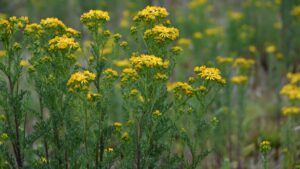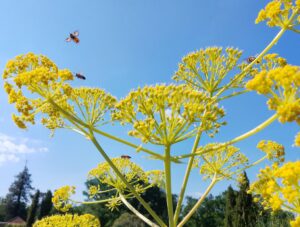
Podcast Episode 36 – The Dove From Above
PODCAST EPISODE 36: The Dove From Above Join us on a beautiful June evening for episode 36 of the Knepp Wildland Podcast. We’re joined by
Home / The Journey to Wilding the Garden ~ May 2021
May began with a cornucopia of weathers; sun, rain, storms, hail in Shakespearean proportions. The Angelica archangelica’s we planted last spring in the Kitchen Garden had reached eight feet, but the weight of their huge umbels and hollow stems thick as a wrist, saw them beaten down, bedraggled in amongst the Meadowsweet. Tulip heads hung in the patio pots, their neck stems guillotined, while new shoots frazzled in late overnight frosts.
The deep low-pressure systems unsettled the bees in the natural hive by the greenhouse, they began to gather in numbers outside the entrance holes, and later we heard a low insistent almost mechanical buzzing. Questioning whether Bernard had started strimming the other side of the wall, we came into the kitchen garden and were greeted with a frenzied cloud of frenetic bees covering a quarter of the garden. We stood back, held in awe for ten minutes or so, before their collective brain settled on gathering in classic inverted pear shape among the lavenders. Cold nights saw them repeating the process for the following days, and finally we watched them disappear above the storks nesting on one of the tall castle chimneys. Matt Somerville who made the hive, visiting not long after, said he’d seen elsewhere how the unsettled weather had reduced food sources and made the normal swarming much later and put many colonies in peril.
While rain continued, we worked on putting the finishing touches to our safari presentation and tour, linking areas of the garden to those key features of rewilding: Tom Stuart Smith’s process driven design, the complex spatial layering, and the idea of the ‘limits of acceptable change’. One of the large Trachelospermum jasminoides that clothes the wall of Acacia Walk had been entirely browned to a crisp by the earlier frosts, the leaves doggedly remaining. In the wider landscape this natural process would occur, we speculate the leaves staying attached to protect new growth from further onslaught. On closer inspection, we could see tiny tentative green buds peaking from the leaf axils along dead looking stems. So, aesthetically, the dry brown draws the eye, highlighted by green flushes of growth from the kiwis and roses either side. Naturally, the leaves would fall eventually and form a mulch around the base, gradually breaking down, preventing moisture loss and improving the structure of the soil. We compromise, reaching a ‘notional tipping point’, taking off the leaves, a few left below and add our own compost to the base, mimicking the natural processes, albeit in speedier fashion.
Ducklings hatch from a nest under the large Acanthus leaves, and the old adage of herding cats could be equally applied, as we try to usher them through gates to reach the lake. The first white rose unfurls on the front of the castle almost a month later than last year’s warm dry spring. The air warms and the blossom of the two Malus transitoria explode in white blossom, so dense as to blot out the leaves, acting like a siren to all manner of bees. Standing under it, your senses are drenched in the hum and bustle and honey scent.

More new plants arrive, the nurseries around the country still hard pressed to fulfil the plant list with so much demand. More storms and rain mean ease of planting, adding to the gravel paths and filling some of the gaps in the long shady border with Hostas and Nepalese creeping bramble, Rubus nepalensis. But the winds bring down a giant; one of the three oaks between the walled garden and the castle terrace, a majestic Goliath felled as in an elemental battle. The three metre expanse of the upturned root foot reveals pulpy wood and few roots of any significant size; they seem strangely insufficient to support the thirty metre trunk. Jamie Simpson, Knepp’s tree specialist guesses the cause to be one of several potential root fungus species found locally. The emerging leaves and rising sap no doubt contributed to a top-heavy leverage in the unseasonal strong winds. The grace of the oak’s fall has mimicked the dignity of its upstanding form, landing almost perfectly in the opening between the yew hedges, leaving its neighbouring behemoths intact and only scratching the shaped yew cones in its crown’s path. The fissured grey bark, the elegant sweep of its limbs puts us in mind of a Henry Moore reclining garden statue, and again this challenge of rewilding, allowing the gardens natural processes; an eyesore, or a host of new habitats and species diversity?
Moy Fierheller Joint Head Gardener May 2021
What we’re reading:
Home | mintopia (bigcartel.com)
RHS Gardening in a Changing Climate report / RHS Gardening
glyphosate-and-soil-health-a-summary1docx.pdf (soilassociation.org)
Pesticides Threaten the ‘Foundations of the Web of Life,’ New Soil Study Warns – EcoWatch
World Bee Day 2021 – The Icon

PODCAST EPISODE 36: The Dove From Above Join us on a beautiful June evening for episode 36 of the Knepp Wildland Podcast. We’re joined by

Matt Phelps | Lead Ecologist It’s mid-June and the countryside is quietly gearing up for its summer crescendo. You might have noticed it already— what

Moy Fierheller | Deputy Head Gardener Visit Knepp’s rewilded Walled Garden The fine, fairy-tale spring continues and the Met Office reports it’s the sunniest in
Knepp Wildland Safaris, our gardens and campsite are all about the quiet and patient observation of nature.
Some of the species we are likely to encounter are shy or can be frightened by loud noises or sudden movements. Our campsite with open-air fire-pits, wood-burning stoves and an on-site pond is unsuitable for small children.
For this reason, our safaris, garden visits, holiday cottages and campsite are suitable only for children of 12 and over.